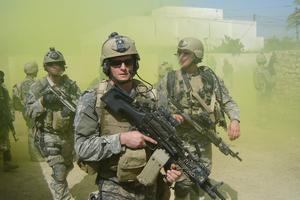2 Classic ‘War Movies’ for Veterans Day Viewing
Honoring courage and humanity, films attest to selflessness in battle and the bravery that must endure.

If you are looking for artful and truthful depictions of what life as a veteran entails, two films rise above all the rest. They were both made in the immediate aftermath of World War II, a time when the devastation of that conflict was still fresh in public consciousness.
Both films had great directors, great screenwriters, great performances; and, most importantly of all, what makes them timeless, they possess a truth only filmmakers with a direct connection to the veteran experience can truly deliver.
Battleground (1949)
Battleground seems to be a traditional “war movie.”
Made in 1949, it tells the story of U.S. infantrymen during the Battle of the Bulge.
The majority of the cast is composed of character actors. The two “stars” are Van Johnson and John Hodiak.
Director William Wellman also may have never achieved John Ford stature as a director, but he did direct a lot of very good films.
Like all screenwriters, Battleground writer Robert Pirosh is rarely remembered.
But what director and writer brought to this film was something you cannot learn in film school: Both men were combat veterans.
When Wellman was a young man, he volunteered to fly with the World War I Lafayette Escadrille; his flying days earned him the name “Wild Bill” Wellman for this aerial combat style.
Writer Pirosh was a soldier at the Battle of the Bulge. He actually trudged through that frozen battlefield landscape of death he would later write about in his script for Battleground.
The film, like war itself, is a series of long, boring routines punctuated by moments of sheer terror. And though it is a very patriotic film in one sense, no character in Battleground is fighting for a cause bigger than just trying to survive or help the guy in the next foxhole do the same.
Veterans who have survived such battles like “the Bulge” do not go around talking about it or ever refer to themselves as heroes.
I have known some of these men in my life, including an uncle who participated in the air war over Germany and a brother who deployed to Southeast Asia. If there were heroes, these survivors, almost to a man, bestow that honor to only those who did not come home.
The focal point of Battleground may be a catastrophic battle, but the film is a celebration of the human spirit and of men in ridiculously awful circumstances they cannot control.
It shows a closed universe where something as benign as savoring fresh eggs can be a source of great joy and turn the mind away from horrors that have happened and horrors yet to come.
It is a world of courage, humanity and, yes, even heroism.
The Best Years of Our Lives (1946)
Sometimes coming home from war takes more courage than battle itself. We now know so much more about post-traumatic stress disorder (PTSD) than we did when The Best Years of Our Lives was released in 1946. Yet this film, populated with A-list actors, does a masterful job of showing how hard it is for veterans returning from war to the life they lived before, but realizing that life is gone forever.
Accomplished director William Wyler was middle-aged when World War II broke out. Still, he put his career on hold to help the war effort, using his skills and talents as best he could. That included bringing a film crew over to England and making a great documentary, The Memphis Bell, about the planes that participated in the air war in Europe and the men who flew them. Wyler and his film crew flew in those planes on bombing runs. One of his cameramen was killed, and Wyler became deaf in one ear from constant exposure to anti-aircraft artillery shells exploding all around him.
Needless to say, he brought not a little veteran experience to a film about veterans.
The screenwriter of Best Years, Robert Sherwood, was wounded during his service in World War I, so he, too, was no stranger to the grimmer realities of war.
There are no battle scenes in Best Years, but there are epic emotional and spiritual battles going on in every frame as three very different veterans return from war and try to “get back to normal” in small-town America.
It can be painful to watch, especially the performance from non-actor Harold Russell. He plays one of the returning veterans.
In real life, he had been horribly wounded in the war, losing both of his arms just below the elbow. Wyler discovered him in a veteran hospital and insisted he be in his movie.
His character has both physical and mental scars to deal with. He was nominated for an Oscar. Thinking he did not have a chance of winning, the Academy of Motion Picture Arts and Sciences awarded him an honorary Oscar in recognition of his sacrifice. Then he won the Oscar for “Best Supporting Actor,” becoming the only person who ever won two Oscars for the same performance.
The other two veterans, played by Fredric March and Dana Andrews, give riveting performances, portraying one man’s self-medicating his PTSD with alcohol and the other dealing with night terrors in his sleep.
As real as most of it is, the film does have a traditional “Hollywood” happy ending, yet it still inspires, even though so many real veterans do not have their lives restored by the end of their third act.
This Veterans Day, The Best Years of Our Lives and Battleground are worth seeking out, as they attest to what being a veteran means to veterans — and what it should mean to the rest of us.
- Keywords:
- veterans day
- veterans
- classic movies
- robert brennan
















